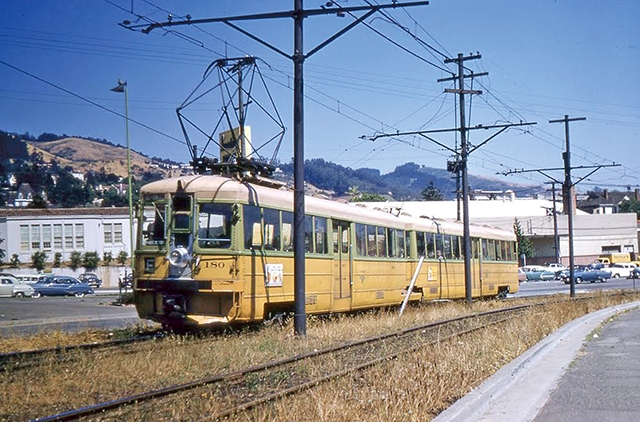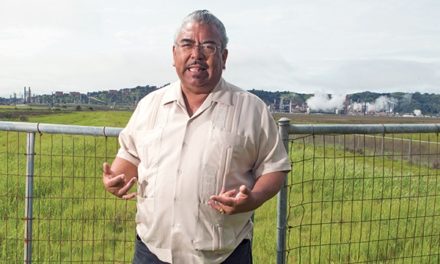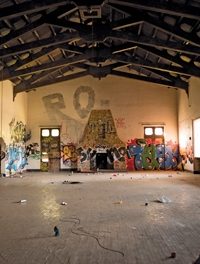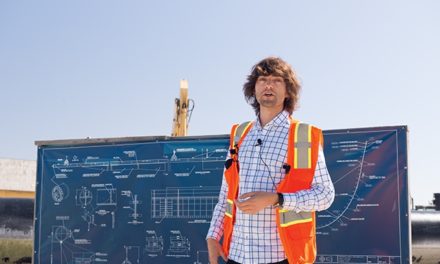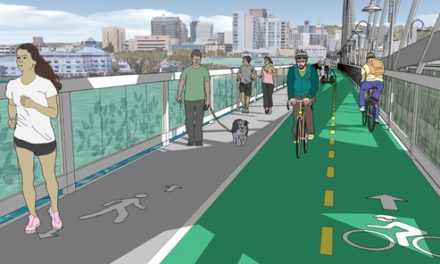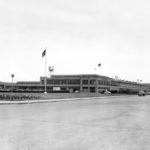By 1957 when this photo of the Key System’s Route F at Shattuck Place in Berkeley was taken, the trains were decrepit.
Believe it or not, the East Bay used to have a locally owned, all-electric, zero-emission mass transit system. And it went nearly everywhere.
There are times when the past seems more progressive than the present—futuristic, even.
A little less than a century ago, the East Bay was home to a bustling network of electric trains, trolleys, and ferries that whisked commuters to and fro, with service spanning Oakland, Berkeley, Emeryville, Piedmont, Alameda, and Richmond.
Before BART and AC Transit, a bevy of interurban rail companies competed for a commuter’s fare in the East Bay, much like today’s fleets of competing Ubers and Lyfts circulating the streets with the same routine efficiency.
The biggest of these companies was Southern Pacific, which had operated its coal-powered steam trains in the area since 1863. Responding to a demand from residents for trains with less noise and smoke, a coalition of wealthy landowners who called themselves the Realty Syndicate—principally financed by mining magnate Francis “Borax” Smith—incorporated in 1902 and challenged Southern Pacific’s monopoly of the area. The group consolidated local rail lines to create a new, electric interurban railway system originally called the San Francisco, Oakland, San Jose Railway, renamed the “Key System” in 1938, so dubbed for its key-like shape.
Smith was also, at the time, the largest landowner in the East Bay and knew, as any savvy businessman does, that a good transit system increases property values.
“It was an enchanting, very fun to ride,” recalled John Stashik, a Key System expert who grew up riding the Key trains and today boasts an extensive collection of Key System and other interurban railway photos. “The Key System employed hundreds of people during its heyday, metalworkers, technicians—they made their own original trains and electrical equipment at shops in Emeryville. It was made by people who knew how to do things.”
The Key System connected to the Key System Pier in Oakland, a 3-mile ferry port that jutted into the water south of where the Bay Bridge begins now. The Key System electric ferries provided a transbay commute that was 20 minutes shorter than Southern Pacific’s ferry commute from its Alameda pier. The Key System ferries were opulent, with carved wooden benches, stained glass windows, and inlaid tiled floors.
For the first time, Southern Pacific’s monopoly had real competition—20 million commuters in 1903 chose the Key System over Southern Pacific. The competition between Southern Pacific, a giant conglomerate, and the locally and independently owned Key System created an impressive transit system for East Bay residents, with Southern Pacific and Key System trains running side-by-side on tracks around the area. By 1924, more than 800 Key System trains brought passengers to ferry boats at the Key System Pier for passage to San Francisco.
The Bay Bridge opened in 1936, and by 1939, train access was added to the bridge, with two train tracks spanning the lower level. Imagine today soaring above the water on a train, smelling the ocean air through glass windows and thick fog rolling through the cabin on some mornings, blurring nature and machine.
But at the same time the Bay Bridge was opening, National City Lines, a once-small bus fleet in Minnesota organized into a holding company with equity funding from General Motors, Firestone Rubber, Phillips Petroleum, Standard Oil of California (which later became Chevron), and Mack Trucks, began purchasing local transportation systems across the United States.
It was a corporate conspiracy staged to monopolize the sale of buses across the United States—buses exclusively fueled by Phillips and Standard gasoline, made by Mack and GM, and driven on Firestone tires.
By 1939, National City Lines owned 29 transportation companies in 27 cities across 10 states. By 1946, it controlled 46 transportation companies in 45 cities across 16 states.
In 1940, East Bay residents had their choice of railway: You could take a Key System or a Southern Pacific train across the Bay Bridge, a Northwestern Pacific Electric Train around Marin, or a Sacramento Northern interurban train all the way to Chico, 180 miles away.
But by Dec. 7, 1941, when Pearl Harbor was attacked, all but the Key System and the Southern Pacific were gone—gobbled up almost overnight. National City Lines tore up the tracks and the overhead wires and burned the trolley and train cars. In 1946, it acquired a majority stake of Key System stock and slowly began dismantling the system.
In the late 1940s, the U.S. government won court decisions against National City Lines, GM, Mack Trucks, Phillips Petroleum, and Firestone Rubber for violating the Sherman Anti-Trust Act. The verdicts were upheld on appeal in 1951. But GM was fined just $5,000.
While GM and its partners killed local rail systems around the nation, the death of the Key System was really one of attrition. Ridership tanked in the post-war years as more families bought cars and moved to the suburbs. Maintenance on Key System trains was costly and frequent, and workers’ strikes complicated issues further.
Key System train service officially ended in 1958. In 1960, it was sold to the newly formed public agency AC Transit. Some of the old streetcars still survive today at the Western Railway Museum in Suisun City, where they have been on display longer than they ran on local streets.
“Everything looks better in the past,” said Stashik. “But patronage was already on a steep decline. The Key System tracks were really beat up, and the trains swayed side to side—a classic symptom of bad track. They were reusing the guts and controllers from the old 1905 cars and were discontinuing some of the more obscure streetcar routes long before National City Lines appeared.

